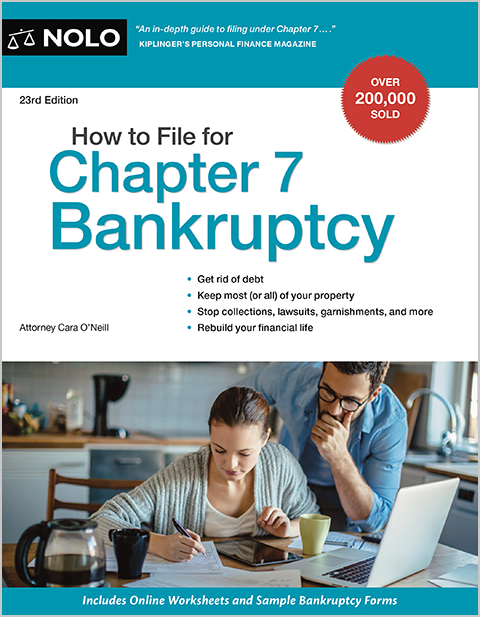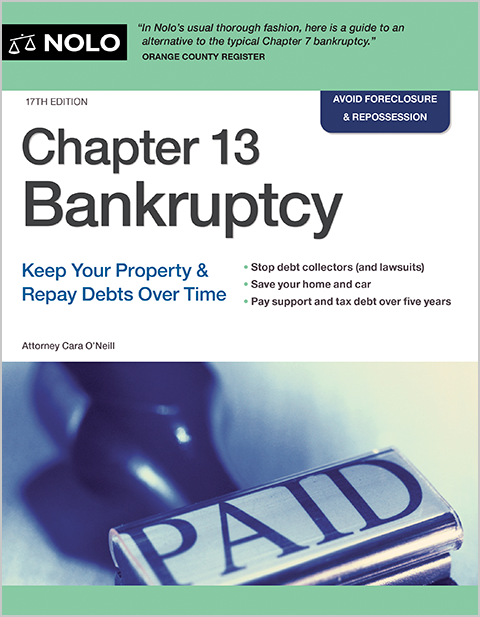In Chapter 7 bankruptcy, you can keep property secured by collateral (such as your car) by reaffirming the debt.
Bankruptcy helps you get out of debt by breaking the contract between you and your creditors. Sometimes, however, you'd like to keep a loan in place, especially if you want to retain the property securing the debt, such as a car.
The reaffirmation process lets you remain responsible for a debt, such as a car payment, and keep the car or other "collateral" property securing the debt. You and the lender enter into a new contract—usually on the same terms—and submit it to the bankruptcy court.
Before entering into a reaffirmation agreement, it helps if you're current on the loan payments, but some lenders will negotiate new terms with you. However, a lender isn't required to do so, so it's best to be current before filing for Chapter 7.
Also, you must meet another requirement. You must be able to protect all of the equity in the property with a bankruptcy exemption. If you can't exempt all of the property's equity, the trustee will sell the asset and use the proceeds to pay your unsecured creditors.
- What Is a Chapter 7 Bankruptcy Reaffirmation?
- Advantages to Reaffirmation in Chapter 7
- How Reaffirmation Affects Your Chapter 7 Bankruptcy
- Restrictions on Reaffirmation
- When to Enter Into a Reaffirmation Agreement
- Keep Current on Payments You Wish to Reaffirm
- Differences Between Collateral and Secured Debt
- Speak With a Bankruptcy Attorney
- Need More Bankruptcy Help?
What Is a Chapter 7 Bankruptcy Reaffirmation?
When you reaffirm a debt, you agree that you will still owe it after your bankruptcy case ends. Both the creditor's lien on the collateral (which gives the creditor the right to take the property if you fail to pay as agreed) and your liability to pay the debt will survive bankruptcy intact.
In most cases, it will be as if you never filed for bankruptcy for that debt.
Advantages to Reaffirmation in Chapter 7
Reaffirmation provides a sure way to keep collateral as long as you abide by the terms of the reaffirmation agreement and keep up your payments. If you stay current on the payment, the lender won't be able to take back the property.
Reaffirmation also provides an opportunity to negotiate new terms to reduce your payments, your interest rate, or the total amount you will have to pay over time. However, the lender doesn't have to agree to new terms and most reaffirmation agreements are on the original contract terms.
How Reaffirmation Affects Your Chapter 7 Bankruptcy
Because reaffirmation leaves you personally liable for the debt, you can't walk away from the debt after bankruptcy. You'll still be legally bound to pay the deficiency balance even if the property is damaged or destroyed. And because you have to wait eight years before filing another Chapter 7 bankruptcy case, you'll be stuck with that debt for a long time.
For instance, if you reaffirm your car note and then default on your payments after bankruptcy, the creditor can (and probably will) repossess the car, auction it off, and bill you for the difference between what you owe and what the trustee received at auction.
Example 1. Suppose you owe $25,000 on your car before filing for Chapter 7 bankruptcy. You most likely will continue to owe $25,000 on your car after you file for bankruptcy (unless you negotiate a lower amount in your reaffirmation agreement). If you can't keep up your payments and the car is repossessed, you'll owe the difference between the $25,000 reaffirmation amount and the amount the lender sells the car for at auction, or "deficiency balance," which will be considerably less than you owe, in most cases). Nearly all states permit a creditor to sue for a deficiency balance. However, about half of the states don't allow deficiency balances on repossessed personal property if the original purchase price was less than a few thousand dollars.
Example 2. Tasha owes $1,500 on a computer worth $900 and reaffirms the debt for the full $1,500. Two months after bankruptcy, she spills a soft drink ruining the computer. Because she reaffirmed the obligation, she still must pay the creditor the remaining balance.
Restrictions on Reaffirmation
The first step is ensuring the Chapter 7 bankruptcy trustee won't sell your property. If you can't protect all of the equity with a bankruptcy exemption, the trustee will sell it, pay the lender, give you the exemption amount, and use the remaining proceeds to pay unsecured creditors.
However, if you can protect all of the property equity, you can use a reaffirmation agreement and continue paying on "secured" property that's encumbered by a lien. You and the creditor must agree to any change in terms.
Also, you or the lender must file the agreement in court as part of the bankruptcy case. The bankruptcy court must review the agreement in a reaffirmation hearing if an attorney does not represent you. If you have a lawyer, the lawyer must sign the agreement and attest that you can afford the payment and that it won't cause undue financial hardship.
At the hearing, the judge will consider how the reaffirmation might affect your post-bankruptcy budget and whether you can afford the payments. The judge can reject the agreement if it isn't in your best interest or would create an undue hardship for you or your family.
Reaffirmation agreement rejections occur when it appears that you can't afford the payments after paying your basic living expenses or if you owe much more on the debt than the property is worth. The bankruptcy judge will make this determination after reviewing the income and expense forms filed with the bankruptcy petition in your case.
When to Enter Into a Reaffirmation Agreement
Sometimes a lender will let you keep a car or other property without filing a reaffirmation agreement as long as you continue making your payment. This is a good way to go because if the lender repossesses the property because you can't make your payments, or you let the car go back to the lender after an accident, you won't be responsible for paying anything further.
That won't be the case if you enter into a reaffirmation agreement. Because reaffirming a debt comes with the disadvantage of leaving you in debt after your bankruptcy case ends, you should consider it only if:
- the creditor insists on it
- it's the only way to keep property you need, and
- you have good reason to believe you'll be able to pay off the balance.
Reaffirmation might be the only practical way to keep some property types, such as automobiles or your home. Also, reaffirmation can be a sensible way to keep property that is worth significantly more than what you owe on it.
If you decide to reaffirm a debt, it's usually worth asking the creditor to accept less than you owe as full payment. For most people, it's not a good idea to reaffirm a debt for more than what it would cost you to replace the property.
Learn more in Your Home in Chapter 7 Bankruptcy and Your Car in Chapter 7 Bankruptcy.
Keep Current on Payments You Wish to Reaffirm
If you need the collateral, you'll want to be current on your payments before filing for bankruptcy to stay on the creditor's good side. If you fall behind, the creditor can demand that you bring your account current before agreeing to a reaffirmation contract.
Differences Between Collateral and Secured Debt
It's common to wonder how secured and unsecured debts differ. The answer is simpler than you might think.
When applying for a credit account or taking out a loan, the lender might ask you to put up collateral (valuable property) that it can sell if you fail to pay your bill—especially when borrowing a large sum of money. The collateral assures or guarantees the lender that it will get paid if you stop making your payment as agreed.
Securing a loan with collateral creates a "lien" on the property, a type of ownership interest that remains until the borrower pays off the debt. The lien interest gives a creditor the right to repossess your vehicle if you fail to make your payment. Likewise, if you fall behind on your mortgage, the lien will allow the lender to foreclose on your home.
A bank or creditor who owns a collateralized debt has what is called a "secured debt." If the bank seeks reimbursement in a bankruptcy case, it will file a "secured claim." If the bankruptcy trustee sells the property, the trustee must pay the secured lender first before distributing funds to unsecured creditors.
However, not all creditors require a borrower to provide security when making a loan or providing a credit service. An "unsecured" creditor doesn't have a lien interest in collateral, so it can't sell the borrower's property to pay off the debt without doing more.
Credit cards, medical bills, and personal loans, such as payday loans are all examples of unsecured debt. An unsecured creditor can gain a security interest by winning a debt collection lawsuit and recording the money judgment with the local recorder's office or the appropriate state agency.
Speak With a Bankruptcy Attorney
If you want to keep your car, home, or other property in Chapter 7, a reaffirmation agreement might be the way to go. But it might not be in your best interests. A local bankruptcy lawyer can explain your options and help you make the right decision for you.
Learn more about why you should hire a bankruptcy lawyer and options if you can't afford a bankruptcy lawyer.
Need More Bankruptcy Help?
Did you know Nolo has been making the law easy for over fifty years? It's true—and we want to make sure you find what you need. Below you'll find more articles explaining how bankruptcy works. And don't forget that our bankruptcy homepage is the best place to start if you have other questions!
|
Our Editor's Picks for You |
|
|
More Like This |
What Happens to Liens in Chapter 7 Bankruptcy? Motor Vehicle Exemption: Can I Keep My Car in Chapter 7 Bankruptcy? |
|
Consider Before Filing for Bankruptcy |
How to File for Bankruptcy in Your State Preparing for Bankruptcy: What to Do With Bank Accounts, Automatic Payments, and Utility Accounts |
|
Helpful Bankruptcy Sites |
We wholeheartedly encourage research and learning, but online articles can't address all bankruptcy issues or the facts of your case. The best way to protect your assets in bankruptcy is by hiring a local bankruptcy lawyer.
|
|
- What Is a Chapter 7 Bankruptcy Reaffirmation?
- Advantages to Reaffirmation in Chapter 7
- How Reaffirmation Affects Your Chapter 7 Bankruptcy
- Restrictions on Reaffirmation
- When to Enter Into a Reaffirmation Agreement
- Keep Current on Payments You Wish to Reaffirm
- Differences Between Collateral and Secured Debt
- Speak With a Bankruptcy Attorney
- Need More Bankruptcy Help?

